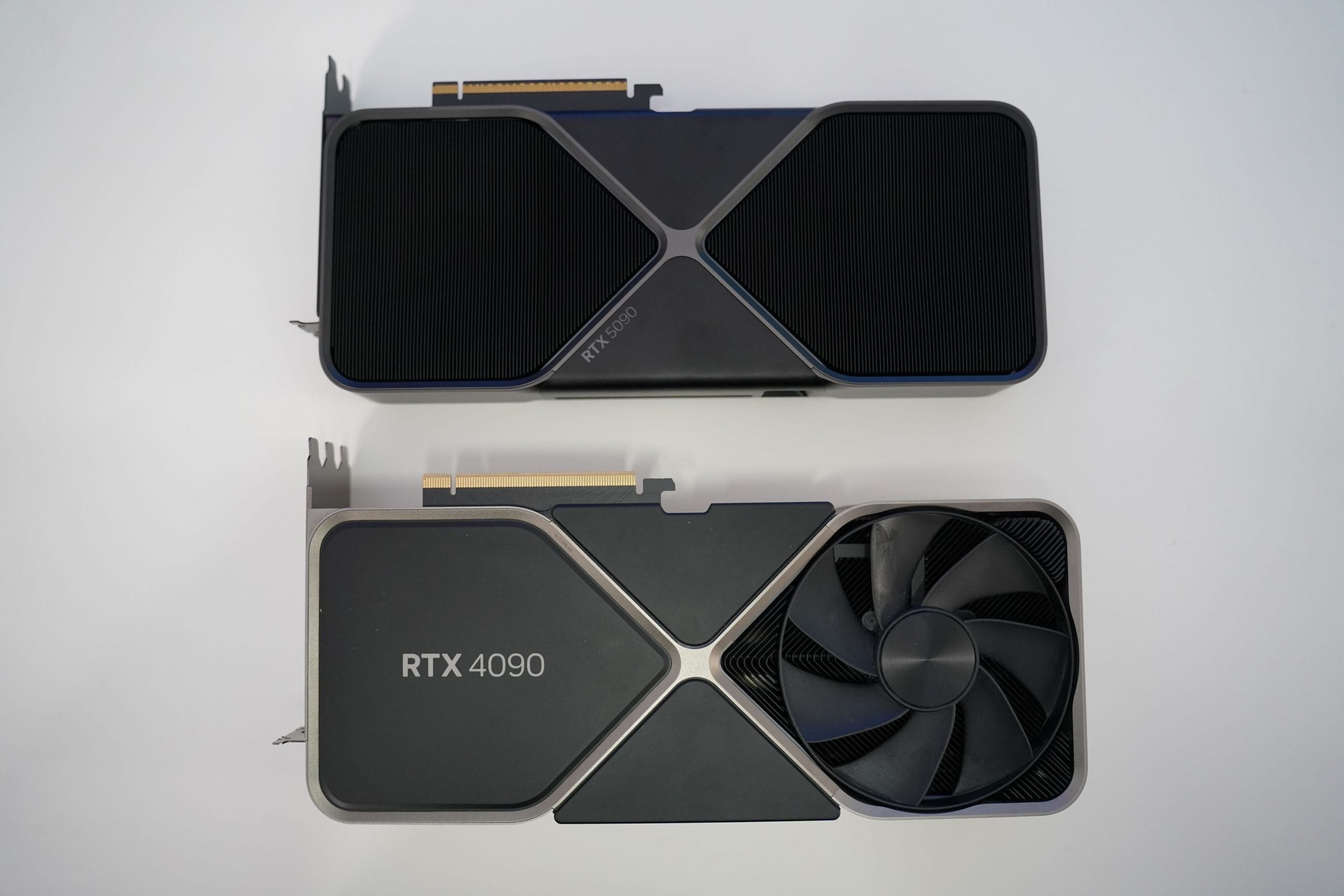NVIDIA has officially launched its highly anticipated RTX 5090, the next-gen flagship GPU of the RTX 50-series. With the RTX 4090 still dominating the GPU market since 2022, many are asking: Is the RTX 5090 really a big step forward?
Whether you’re a hardcore gamer, 3D artist, or AI developer, this RTX 4090 vs RTX 5090 comparison will help you understand which graphics card truly delivers in 2025.
⚙️ Quick Spec Comparison
| Spec | RTX 4090 (2022) | RTX 5090 (2025) |
|---|---|---|
| Architecture | Ada Lovelace | Blackwell |
| CUDA Cores | 16,384 | 24,576+ (est.) |
| VRAM | 24GB GDDR6X | 32GB GDDR7 |
| Ray Tracing Cores | 3rd Gen | 4th Gen |
| AI Tensor Cores | 4th Gen | 5th Gen |
| Power Consumption | ~450W | ~350–400W (more efficient) |
| MSRP | $1,599 | $1,799 (launch price) |
🚀 Performance Benchmarks: Gaming & Rendering
🕹️ Gaming FPS (4K, Ultra Settings)
| Game | RTX 4090 Avg FPS | RTX 5090 Avg FPS |
|---|---|---|
| Cyberpunk 2077 | 92 FPS | 118 FPS |
| Hogwarts Legacy | 102 FPS | 130 FPS |
| Starfield | 89 FPS | 115 FPS |
| Flight Simulator | 72 FPS | 95 FPS |
| Red Dead Redemption 2 | 124 FPS | 158 FPS |
📈 Overall Gaming Boost: ~25–35% better performance at 4K on RTX 5090.
🎨 Creative Workloads & AI Tasks
Render Times (Blender BMW Test):
RTX 4090: ~30 seconds
RTX 5090: ~19 seconds
Stable Diffusion Generation (25 Steps, 1024×1024):
RTX 4090: ~3.5s
RTX 5090: ~2.2s
Video Editing (8K RED RAW Export):
25% faster export times with RTX 5090 in DaVinci Resolve
🌈 Ray Tracing and DLSS: New Tech Edge
RTX 5090 Brings:
DLSS 4.0: Even sharper upscaling with lower latency
4th-Gen Ray Tracing Cores: Better reflections and shadows with less performance hit
AI-Driven Lighting Enhancements: More realistic ambient lighting and global illumination
Visual Differences
In games like Alan Wake 2 and Metro Exodus Enhanced, RTX 5090 provides noticeably smoother ray-traced lighting and higher-quality reflections — especially with DLSS 4 activated.
🔋 Power Efficiency & Thermals
NVIDIA focused on power efficiency with the RTX 5090:
Slightly lower peak wattage than RTX 4090
Better thermals with improved vapor chamber cooling
Runs cooler (~6–8°C lower under full load)
This means quieter fans and better performance per watt — great for smaller cases or multi-GPU builds.
💡 Real-World User Insights
“Upgrading to the RTX 5090 cut my Stable Diffusion generation time in half. It’s the first time I’ve felt a real generational leap since the 3080.”
— Nico, AI Artist & 3D Modeler
“I was getting frame drops in Starfield with my 4090. The 5090 smoothed it out completely at 4K Ultra. DLSS 4 is mind-blowing.”
— Kris, PC Gamer & Streamer
“It’s expensive, but for content creators, the 5090 is a productivity monster.”
— Lena, YouTube Video Editor
❓ Should You Upgrade?
Upgrade to RTX 5090 if:
You game at 4K or ultrawide
You work with AI tools, 3D rendering, or large video projects
You want futureproofing for the next 3–5 years
You need the best GPU for work and play
Stick with RTX 4090 if:
You already own one — it’s still very powerful
You game at 1440p or don’t use ray tracing
You want to save money for the rest of your rig
🔮 What About Mid-Range GPUs?
If you’re waiting for the RTX 5080 or 5070, NVIDIA is expected to release them later in 2025. These cards may offer 80–90% of the 5090’s performance at much better prices — ideal for most gamers and creators.
📌 Final Verdict: RTX 4090 vs RTX 5090
| Category | Winner |
|---|---|
| 4K Gaming | RTX 5090 |
| AI Workloads | RTX 5090 |
| Ray Tracing Performance | RTX 5090 |
| Power Efficiency | RTX 5090 |
| Price-to-Performance | RTX 4090 |
| Availability | RTX 4090 |
Conclusion: The RTX 5090 is a true flagship GPU with major gains in speed, visuals, and efficiency. But if you already own an RTX 4090, you’re still sitting on a beast of a card.


